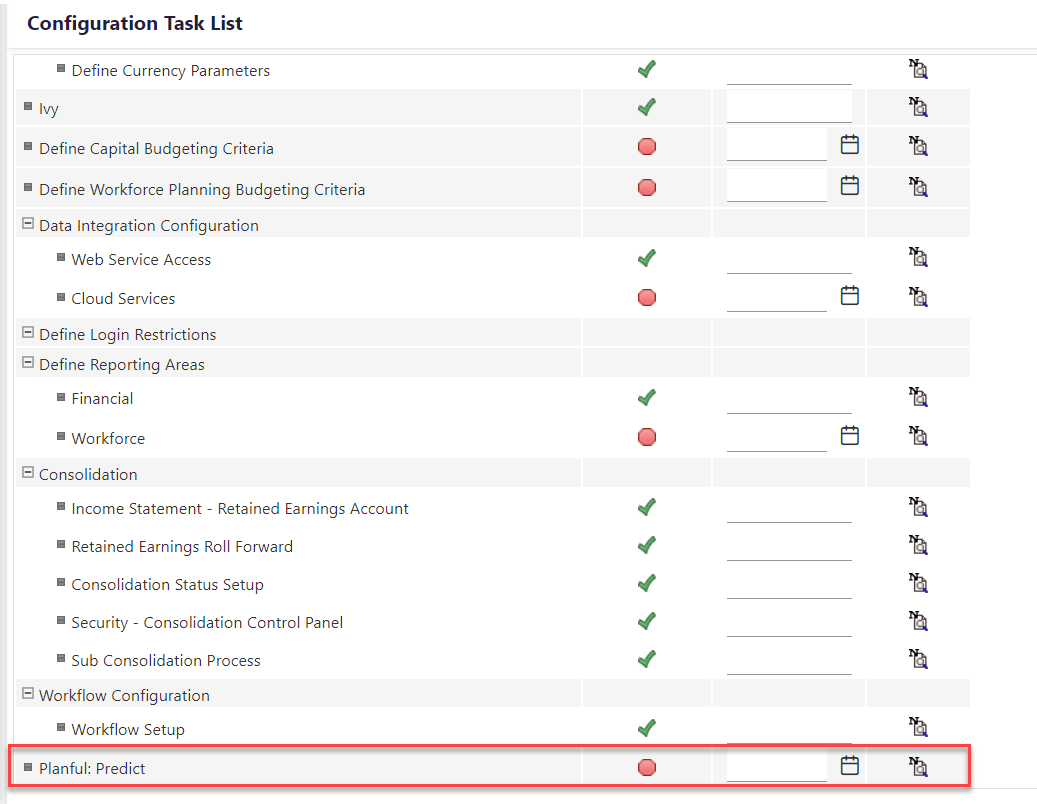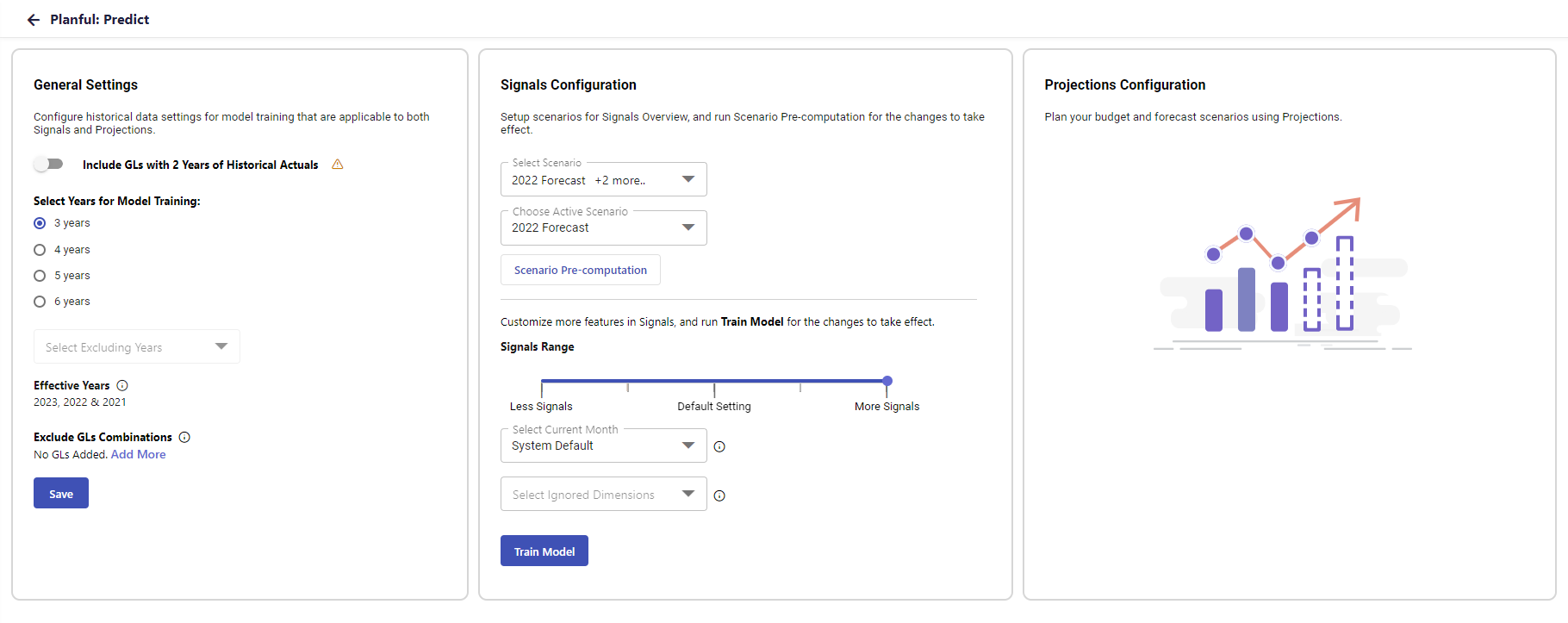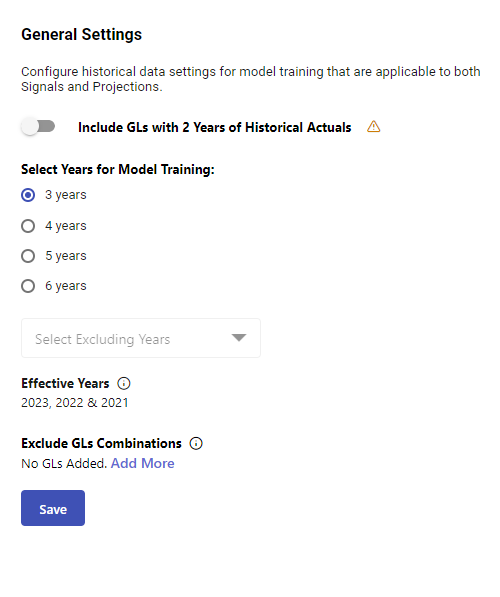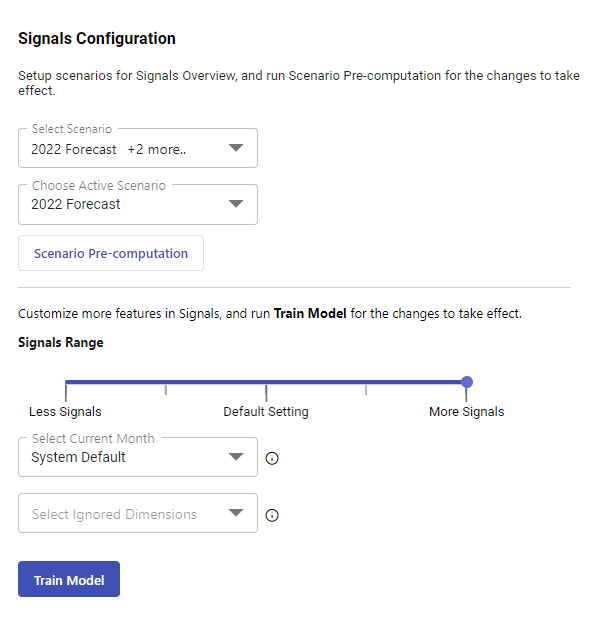- 5 Minutes to read
- Print
- DarkLight
- PDF
Setting Up Predict
- 5 Minutes to read
- Print
- DarkLight
- PDF
The admin screen allows you to perform all Predict administrative configurations from a single page. Follow the below tabs for step-by-step instructions on setting up Predict.
Configuring General Settings
After the Account Manager has enabled the Predict functionality in your application, admin users must configure the general settings for Signals and Projections and initiate the Model Training process.
To configure the general settings for both Signals and Projections, do the following:
- Navigate to Maintenance > Admin > Configuration Tasks > Planful: Predict.
 The Planful: Predict configuration page displays.
The Planful: Predict configuration page displays.
- In the General Settings section, you can make the below selections which will apply to both Signals and Projections:

- Include GLs with 2 Years of Historical Data - Select GLs with 2 years of historical data for model training. Still, we recommend having at least 3 years of GL data for more accurate signals and projections.
- Select Years for Model Training - Select the desired number of historical years for model training. 2 years is the minimum, but more can be selected if desired.
- Select Excluding Years - Select the years that will be excluded from Model Training the drop-down list.
- Add GL Combinations -Select the dimension members you want to exclude from Predict. This is optional.
- Click the Add GL Combinations link to exclude unwanted GL combinations.
The Add GL Combinations screen appears.
- Select the dimension members from the respective fields, and click Submit.
Note:You can add a maximum of 10 rows to the list. - Click the Add GL Combinations link to exclude unwanted GL combinations.
- Click Save to train the model.
Configuring Signals
After the Account Manager has enabled the Predict Signals functionality in your application, admin users must set up Pre-computation Scenarios and initiate the Model Training process.
To configure Predict Signals, do the following:
- Navigate to Maintenance > Admin > Configuration Tasks > Planful: Predict.

The Planful: Predict configuration page displays.
- In the Signals Configuration section, you can make the below selections for Scenario(s) Pre-computation.

- Select Scenario - Select the desired number of scenarios for Pre-computation. Currently, you can only select up to three Scenarios.
- Choose Active Scenario - Select the desired scenario from the list to generate the Signals Overview report.
- Click Scenario Pre-computation.
- You can make further selections which will apply to Signals:
- Signals Range - You can modify the number of signals generated using this option.
- Select Current Month -You can adjust the months as per your requirement from the respective fields.Note:The current Calendar month will be considered as the value of the System Default option. You can select 3 months before and after the current month using the drop-down menu.
- Select Ignored Dimensions -You can also select the dimensions you want to ignore. Note:Optionally, you can ignore a maximum of two dimensions.
- Once you have configured the required fields, click Train Model.Note:For the changes to take effect you must trigger the Model Training process. This step is necessary to ensure that the updated number of Signals is displayed in DR and the Signals Overview screen.
Pre-computation
The pre-computation of selected scenarios is the process of storing signals data for the scenarios specifically chosen from the database.
When you select a scenario for which the signal information is already available in the application due to pre-computation, the Signal summary is displayed quickly, thereby saving time to fetch the required data.
The Pre-computation process compares the user's forecasted or budgeted data against the AI-generated statistical ranges from the Model Training algorithm. The Model Training algorithm output comprises an upper range and a lower range.
Following are a few important points to understand pre-computation of scenarios.
If the forecasted or budgeted data falls within the AI-generated statistical range, the Signals AI engine will not generate any signals and show anomalies.
If the forecasted or budgeted data does not fall within the AI-generated statistical range, the Signals AI engine will generate signals and show anomalies. Also, the AI engine-generated data is stored in the database to display the signals.
If the selected scenarios contain historical periods as open periods, then the algorithm will run only from the current period onwards.For example: If the selected scenario has open periods as Financial Year 2019, 2020, and 2021, and the current month is November 2020, then the model training algorithms and pre-computation algorithms will consider open periods from November 2020 onwards until December 2021. The model training algorithms and pre-computation algorithms will not consider the periods between January 2019 and October 2020, even though the selected scenario has open periods starting from January 2019.
If any of the selected scenarios are locked, the Pre-computation process will run, and the signals and AI-generated statistical range will be generated.
You will be displayed signals of scenarios to which you have already been given access.
Admin users can select up to 3 scenarios for Pre-computation. You can mark one scenario as an active scenario that will appear as the default selection against the Selection Criteria scenario dimension. Once you select an active scenario, you can initiate the Model Training process.
You can only select Budget and Forecast scenarios.
Scenario dimension in Selection Criteria will contain only those scenarios the admin users configure.
You must select the Pre-computation scenario before using the Predict Signals functionality.
Whenever you update data in the Pre-computed scenarios, then you must rerun the Pre-computation.
If the selected scenario is deleted:
When one of the existing Pre-computed scenarios is deleted from configuration selection, any signals data against the scenario will no longer be available.
If any of the users use the deleted scenario, the signals dashboard will not display any data when they refresh the page.
You must select any scenario from the list of newly available scenarios in the Selection Criteria.
Note:For newly selected scenarios, signals data available for users on Pre-computed scenarios is displayed in the user’s dashboards only after the Pre-computation process is complete.
Model Training
Model training is the process of training the algorithm with the available historical actuals data to generate AI-driven statistical ranges for signals. You can select the required Scenario, Dimension, Month, and Signals Range from the respective fields. It is an integral step after enabling the Predict Signals functionality and selecting the Pre-computation Scenarios.
Planful recommends that there are at least 48 months of historical actuals data. However, the algorithm requires a minimum of 36 months of historical actuals to generate proper data-driven signals. Also, signal detection will be more effective with a greater number of historical actuals periods.
Once you select Train Model, you do not have to explicitly click Scenario Pre-computation, as this process will automatically be executed as part of Model Training for the selected Scenario.
When you make changes to the budget/forecast data for which you had earlier run the model training, you just have to run the pre-computation and not the model training process.
As and when new actuals are captured by the system for the ongoing financial year, you must initiate the Model Training process to calculate signals based on the latest data. However, Planful recommends initiating the model training once every 3 to 6 months.
You will receive an email notification once the Model training process is completed. You will see a message on the application screen once you refresh the application post the Model training.
Note:If there are no changes to historical actuals data and you want to update only the list of Pre-computed scenarios, you can click Scenario & Pre-computation. You need not run the Model Training process as long as the actuals data is not modified.

 The Planful: Predict configuration page displays.
The Planful: Predict configuration page displays.


